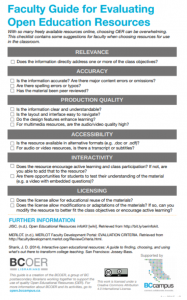What is the difference between online educational content and openly licensed educational content?
This week in EDCI339, we discussed open educational resources (OER). Now, we are able to understand the difference between online educational content and openly licensed educational content. The tutorial on OER featured a video entitled “What are open licenses and how do they work?” According to Nicole Allen, a woman in this video, educational resource are automatically copyrighted when they are created. The distinction between online educational content and openly licensed educational content is that the latter has an open license. This license enables the public to access the content for free. One of the most common open licenses is the Creative Commons Attribution license which states that anyone can use the content for free as along as proper and accurate attribution is given to the creator of the resource. This license makes access easy and allow the user to remix the works with other openly licenced works. Openly licenced educational content includes open educational resources (OER) and open courseware (OCW) if an open license is applied. Online educational content is a broader category that includes open content and content with more limited access if the content is published online for educational purposes.
OER Evaluation
The OER I chose to evaluate is an online article about electronic orbitals that is published under and open license on lumenlearning.com. I found this resource using the search procedure outlines in the tutorial. I chose this topic because I am a fourth-year chemistry student who has taken many courses concerning quantum mechanics and electronic phenomena in atoms.
 Please click here to access this resource. I have used the evaluation guide on the tutorial to evaluate this resource. This guide is broken down into the following categories: relevance, accuracy, production quality, accessibility, interactivity, and licensing.
Please click here to access this resource. I have used the evaluation guide on the tutorial to evaluate this resource. This guide is broken down into the following categories: relevance, accuracy, production quality, accessibility, interactivity, and licensing.
Relevance and accuracy: 3/4
The provide information is relevant and accurate without any spelling errors. However, the website does not specify whether the content has been peer-reviewed.
Production quality: 2/4
There are no multimedia features and the resource should include more pictures to compare different possible shapes of electron orbitals.
Accessibility: 1/2
This resource is not available in alternate forms like pdf or doc. The transcript criterion does not apply since there are no videos or audio features.
Interactivity: 1/2
There is no quiz feature or interactive component. However, the information is broken down into headings such as “Key Points” and “Terms.” This means that it would be easy to create quiz questions based on these points and terms.
Licensing: 2/2
The license allows full access and modification.
Total: 9/14
How do I use OER in my life?
I often use OER to improve my academics. This occurs when I am studying for tests or doing research for assignments. For example, when I study for a chemistry exam, I rely mainly on the course textbook and my notes. However, sometimes I feel like I should clarify the concept with another resource. Occasionally, I feel like don’t have enough background knowledge to fully understand the course textbook. In these cases, OER are useful to help me fill the gaps and substantiate my understanding of the topic. Although I am not in an essay-based program, I have had to write a few papers. For these papers, OER can be useful references as I research the topic of the paper. In either case, having free access to accurate academic information allows me to take control of my education while continuing to learn about topics I care about most.
Attribution: The above image was made by BCOER Librarians and was accesses through the tutorial “How to Evaluate Open Content” and can by accessed through www.oerafrica.org/book/how-evaluate-open-content.
